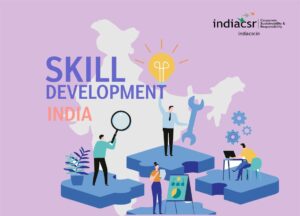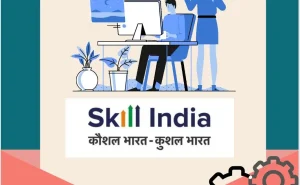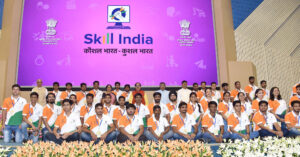Introduction:-
The Skill India project stands as one of the most ambitious and impactful initiatives undertaken by the Indian government to address the pressing issue of unemployment and skill shortage. With a vision to harness the potential of India’s demographic dividend and transform it into a demographic dividend, the Skill India campaign aims to equip millions of Indian youth with relevant skills and knowledge to enhance their employability and entrepreneurial capabilities.
History and Background:
The history and background of the Skill India initiative are deeply rooted in India’s socio-economic landscape, shaped by the country’s quest for inclusive growth and sustainable development. To delve into this topic comprehensively, we need to explore various facets, including the genesis of the Skill India campaign, its evolution over the years, key milestones, and the broader context in which it operates.
Genesis of the Skill India Initiative:-
The genesis of the Skill India initiative can be traced back to the early years of the 21st century when India began to grapple with the dual challenges of demographic dividend and skill deficit. With a burgeoning youth population and rapid urbanization, there was a growing recognition of the need to harness the demographic dividend by equipping the workforce with relevant skills and competencies.
Evolution Over the Years:
The concept of skill development gained momentum with the launch of various government schemes and programs aimed at enhancing employability and fostering entrepreneurship. However, it was not until the advent of the Skill India campaign in 2015 that a comprehensive and coordinated approach to skill development was adopted at the national level.
Key Milestones:
Several key milestones mark the evolution of the Skill India initiative, including the establishment of the Ministry of Skill Development and Entrepreneurship (MSDE) in 2014, the launch of the Pradhan Mantri Kaushal Vikas Yojana (PMKVY) to provide skill training to youth across the country, and the introduction of various other flagship schemes and programs aimed at different segments of the population.
Broader Context:
The Skill India initiative operates within the broader context of India’s development agenda, which seeks to harness the potential of its demographic dividend to drive economic growth and social progress. It is aligned with national priorities such as Make in India, Digital India, and Startup India, which aim to create an enabling environment for job creation, entrepreneurship, and innovation.
Key Components of Skill India:
Skill Development Initiatives
Central to the Skill India campaign are skill development initiatives designed to provide training and certification in a wide range of trades and professions. These programs aim to bridge the gap between formal education and industry requirements, offering specialized courses tailored to the needs of different sectors.
Vocational Training Programs:
Another vital aspect of the Skill India project is its emphasis on vocational training programs, which provide hands-on experience and practical knowledge to aspiring professionals. These programs are often conducted in collaboration with industry partners, ensuring that participants receive industry-relevant training.
Employment Opportunities:
The ultimate goal of the Skill India project is to create sustainable employment opportunities for skilled individuals across various sectors. By aligning skill development efforts with industry demand, the initiative seeks to catalyze job creation and economic growth, thereby reducing unemployment rates and fostering inclusive development.
Impact and Benefits:
The Skill India project has yielded significant socio-economic benefits since its inception, empowering millions of individuals with marketable skills and enhancing their earning potential. By equipping youth and women with relevant skills, the initiative has not only facilitated their integration into the workforce but also contributed to poverty alleviation and social upliftment.
Implementation and Execution:
The successful implementation of the Skill India project relies on effective collaboration between government agencies, educational institutions, industry bodies, and other stakeholders. Various schemes and policies have been formulated to streamline skill development efforts and ensure their alignment with national development priorities.
Challenges and Roadblocks:
Despite its achievements, the Skill India project faces several challenges, including the need to address regional disparities in skill development, enhance the quality of training programs, and create robust mechanisms for assessing and certifying skills. Additionally, infrastructural limitations and funding constraints pose significant hurdles to the scalability and sustainability of the initiative.
Future Outlook and Expansion:
Skill India is an ambitious initiative launched by the Government of India to enhance the employability and productivity of the country’s workforce. Since its inception, Skill India has made significant strides in imparting skills training and creating employment opportunities for millions of individuals across various sectors. In this comprehensive analysis, we will delve into the future outlook and expansion strategies for the Skill India initiative, exploring key trends, challenges, and opportunities shaping its trajectory.
Evolution of Skill India:
Skill India was launched in 2015 by Prime Minister Narendra Modi as part of the government’s broader vision to empower youth and bridge the skill gap prevalent in the Indian job market. Over the years, the initiative has evolved significantly, encompassing a wide range of skill development programs, vocational training courses, and employment generation schemes. The focus has shifted from traditional classroom-based learning to more practical, industry-relevant training modules tailored to the needs of specific sectors.
Current Landscape:
As of now, Skill India has made commendable progress in terms of skill development and job creation. Various flagship schemes such as Pradhan Mantri Kaushal Vikas Yojana (PMKVY), National Apprenticeship Promotion Scheme (NAPS), and Skill Loan Scheme have been instrumental in providing training to millions of individuals and facilitating their entry into the workforce. Moreover, strategic partnerships with industry players, educational institutions, and international organizations have strengthened the ecosystem for skill development and entrepreneurship.
Key Trends Shaping the Future:
a. Technological Advancements: With rapid advancements in technology, there is a growing demand for skilled professionals in emerging sectors such as artificial intelligence, data analytics, cybersecurity, and digital marketing. Skill India needs to adapt its curriculum and training methodologies to align with these evolving industry trends.
b. Gig Economy: The rise of the gig economy has created new opportunities for freelancers, independent contractors, and gig workers. Skill India must focus on imparting entrepreneurial skills and fostering a culture of innovation and self-employment to tap into this burgeoning segment of the workforce.
c. Remote Learning: The COVID-19 pandemic has accelerated the adoption of online learning and remote training models. Skill India should leverage digital platforms and e-learning technologies to reach a wider audience, especially in rural and remote areas where access to traditional educational infrastructure is limited.
d. Green Skills: With increasing emphasis on sustainability and environmental conservation, there is a growing demand for professionals with expertise in green technologies, renewable energy, and environmental management. Skill India can play a pivotal role in promoting green skills development and fostering a sustainable workforce for the future.
Challenges and Opportunities:
a. Addressing Regional Disparities: One of the primary challenges faced by Skill India is the regional disparity in skill development infrastructure and opportunities. There is a need to decentralize skill development initiatives and establish training centers in underserved regions to ensure equitable access to skills training and employment opportunities.
b. Enhancing Quality of Training: While Skill India has succeeded in scaling up its training programs, ensuring the quality and relevance of training remains a critical concern. There is a need to standardize the curriculum, improve trainer quality, and incorporate industry feedback to make training programs more effective and job-oriented.
c. Industry-Academia Collaboration: Bridging the gap between academia and industry is essential to ensure that skill development efforts are aligned with industry requirements. Skill India should foster closer collaboration between educational institutions and industries to design curricula, offer internships and facilitate job placements for skilled graduates.
d. Leveraging Public-Private Partnerships: Public-private partnerships (PPPs) can be instrumental in scaling up skill development initiatives and leveraging private sector expertise and resources. Skill India should explore opportunities for collaboration with corporate entities, industry associations, and non-profit organizations to enhance the reach and impact of its programs.
Future Strategies and Expansion Plans:
a. Diversification of Courses: Skill India should diversify its course offerings to cover a broader spectrum of skills and industries, including emerging sectors such as healthcare, tourism, logistics, and entertainment. Specialized training programs should be developed to cater to the unique needs of each industry segment.
b. Strengthening Rural Outreach: Given the significant rural population in India, there is a need to intensify efforts to reach out to rural youth and provide them with access to skills training and employment opportunities. Mobile training vans, community-based training centers, and digital outreach programs can help extend the reach of Skill India to remote areas.
c. Focus on Entrepreneurship: Empowering youth with entrepreneurial skills and fostering a culture of innovation and entrepreneurship is critical for driving economic growth and job creation. Skill India should introduce entrepreneurship development programs, mentorship initiatives, and access to finance schemes to encourage aspiring entrepreneurs to start their ventures.
d. International Collaboration: Collaborating with international agencies, governments, and organizations can enhance the global competitiveness of India’s workforce and promote cross-border exchange of skills and knowledge. Skill India should explore partnerships with foreign governments, multilateral agencies, and international training providers to benchmark best practices and leverage global expertise in skill development.
Conclusion
The Skill India project represents a paradigm shift in India’s approach to human resource development, emphasizing the importance of skills and competencies in the 21st-century global economy. By fostering a culture of lifelong learning and entrepreneurship, the initiative holds the key to unlocking India’s full potential and ensuring inclusive growth for all segments of society.

